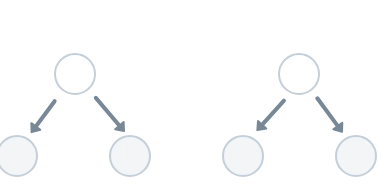Subroutines: Interview Problem Survey
Lets say we have an algorithm which performs a check if a string is a palindrome. bool isPalindrome(string s) { for(int i = 0; i < s.length()/2; i++) { if(s.at(i) != s.at(s.length()-i-1)) { return false; } } return true; } This type of solution can be a subroutine to many questions; which may require pre-processing before calling isPalindrome(). An example may be removing spaces and alphanumeric characters. bool cleanString(string s) { string cleanedstr = ""; for(char c : s) { if(isalnum(c)) { cleanedstr += tolower(c); } } return cleanedstr; } To better use the isPalindrome as a subroutine we can add additional parameters. This can help answering questions like leetcode 680; where at most one character can be deleted. bool isPalindrome(string s, int i, int j) { for(;i= 0) total += depth_first_search(matrix, i, j-1); return total; } int find_largest_island_size(vector matrix) { int max_island = 0; for(int i = 0; i < matix.size(); i++) { for(int j = 0; j < matrix.at(0).size(); j++) { max_island = max(max_island, depth_first_search(matrix, i, j)); } } return max_island } Now we may have scenarios where instead of the classic up, down, left, right search options we have more complex operators such as in leetcode 282. Where we are given a String of numbers and a target number and can introduce binary operators which result in the expression resolving to the target number. The goal is to find all such expressions example instance; "332" 8 example solution; 3+3+2 example code; class Solver { private: vector ans; int target; string number; void dfs(string path, int idx, long long curr, long long prev) { if(idx == num.size()) { if(curr == target) ans.push_back(path); return; } for(int i = idx; i < num.size(); i++) { if(i != idx && num[idx] == '0') break; string snumber = num.substr(idx, i - idx+1) long long number = stoll(snumber); //initially we have no choice but to take the number if(idx == 0) { dfs(path+snumber, i+1, number, number); } else { dfs(path+"+"+snumber, i+1, curr+number, number); dfs(path+"-"+snumber, i+1, curr-number, -number); // during the scenario we multiply we have to remove the // the previous value from our running sum dfs(path+"*"+snumber, i+1, curr-prev+(prev*number), prev * number); } } } public: vector getExpressions(string num, int target) { this->target = target; this->num = num; dfs("", 0,0,0); return ans; } }

Lets say we have an algorithm which performs a check if a string is a palindrome.
bool isPalindrome(string s) {
for(int i = 0; i < s.length()/2; i++) {
if(s.at(i) != s.at(s.length()-i-1)) {
return false;
}
}
return true;
}
This type of solution can be a subroutine to many questions; which may require pre-processing before calling isPalindrome(). An example may be removing spaces and alphanumeric characters.
bool cleanString(string s) {
string cleanedstr = "";
for(char c : s) {
if(isalnum(c)) {
cleanedstr += tolower(c);
}
}
return cleanedstr;
}
To better use the isPalindrome as a subroutine we can add additional parameters. This can help answering questions like leetcode 680; where at most one character can be deleted.
bool isPalindrome(string s, int i, int j) {
for(;iand the parent function handles the case where we may have up to one deleted character.
bool atMostOneMissingPalendrome() {
int i = 0;
int j = s.length() -1;
for(int i = 0, j = s.length()-1; iNow a more common scenario during an interview is having to use depth-first search or breadth first search. One question where this appears is connected-components or connected islands style questions; where you are given a matrix and asked to find the number of islands or the biggest island where a '1' denotes sand presence and '0' denotes water.
example instance;
111000
100011
001010
example solution;
4
example code;
int depth_first_search(vector> matrix, int i, int j) {
if(matrix.at(i).at(j) == 0) {
return 0;
}
int total = 1;
if(i+1 < matrix.size())
total += depth_first_search(matrix, i+1, j);
if(i-1 >= 0)
total += depth_first_search(matrix, i-1, j);
if(j+1 < matrix.at(0).size())
total += depth_first_search(matrix, i, j+1);
if(j-1 >= 0)
total += depth_first_search(matrix, i, j-1);
return total;
}
int find_largest_island_size(vector> matrix) {
int max_island = 0;
for(int i = 0; i < matix.size(); i++) {
for(int j = 0; j < matrix.at(0).size(); j++) {
max_island = max(max_island, depth_first_search(matrix, i, j));
}
}
return max_island
}
Now we may have scenarios where instead of the classic up, down, left, right search options we have more complex operators such as in leetcode 282. Where we are given a String of numbers and a target number and can introduce binary operators which result in the expression resolving to the target number. The goal is to find all such expressions
example instance;
"332" 8
example solution;
3+3+2
example code;
class Solver {
private:
vector ans;
int target;
string number;
void dfs(string path, int idx,
long long curr, long long prev) {
if(idx == num.size()) {
if(curr == target)
ans.push_back(path);
return;
}
for(int i = idx; i < num.size(); i++) {
if(i != idx && num[idx] == '0')
break;
string snumber = num.substr(idx, i - idx+1)
long long number = stoll(snumber);
//initially we have no choice but to take the number
if(idx == 0) {
dfs(path+snumber, i+1, number, number);
} else {
dfs(path+"+"+snumber, i+1, curr+number, number);
dfs(path+"-"+snumber, i+1, curr-number, -number);
// during the scenario we multiply we have to remove the
// the previous value from our running sum
dfs(path+"*"+snumber, i+1, curr-prev+(prev*number), prev * number);
}
}
}
public:
vector getExpressions(string num, int target) {
this->target = target;
this->num = num;
dfs("", 0,0,0);
return ans;
}
}











































































































































































![[The AI Show Episode 142]: ChatGPT’s New Image Generator, Studio Ghibli Craze and Backlash, Gemini 2.5, OpenAI Academy, 4o Updates, Vibe Marketing & xAI Acquires X](https://www.marketingaiinstitute.com/hubfs/ep%20142%20cover.png)




























































































































![[DEALS] The Premium Learn to Code Certification Bundle (97% off) & Other Deals Up To 98% Off – Offers End Soon!](https://www.javacodegeeks.com/wp-content/uploads/2012/12/jcg-logo.jpg)


![From drop-out to software architect with Jason Lengstorf [Podcast #167]](https://cdn.hashnode.com/res/hashnode/image/upload/v1743796461357/f3d19cd7-e6f5-4d7c-8bfc-eb974bc8da68.png?#)








































































































.png?#)























.webp?#)










_Christophe_Coat_Alamy.jpg?#)
 (1).webp?#)




































































































![Apple Considers Delaying Smart Home Hub Until 2026 [Gurman]](https://www.iclarified.com/images/news/96946/96946/96946-640.jpg)
![iPhone 17 Pro Won't Feature Two-Toned Back [Gurman]](https://www.iclarified.com/images/news/96944/96944/96944-640.jpg)
![Tariffs Threaten Apple's $999 iPhone Price Point in the U.S. [Gurman]](https://www.iclarified.com/images/news/96943/96943/96943-640.jpg)



































































































































